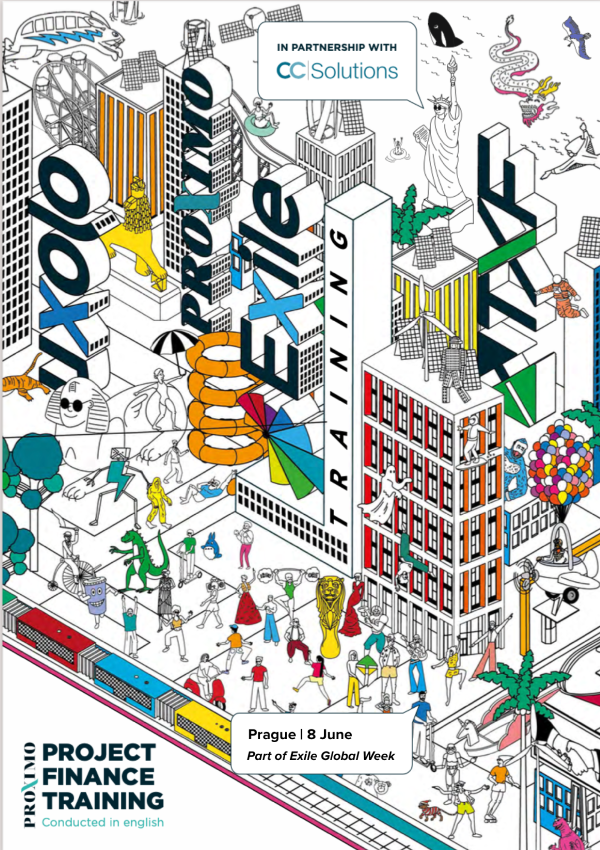Impact finance – the secret to scale is in the blend (part one)
Impact investment and blended finance – both key strategies in attracting private sector funding into energy transition, particularly in developing markets. So how to achieve them? In the first session of a two-part roundtable, Proximo, with support from AXA XL, invited a panel of experts from across the blended finance spectrum to discuss risk, risk mitigation and scaling up.

A roundtable supported by:
Impact finance and investment is enjoying unprecedented appetite and demand on the back of climate change, energy transition and growing ESG awareness. But for all the positive sentiment, what is achievable from blended and impact finance given the global economic headwinds of inflation, rising project and commodities costs and a growing debt crisis in developing markets?
AXA XL and Proximo brought together a panel of experts from insurance, funds, commercial banks and DFIs to answer those questions and much, much more. If you have questions about blended and impact financing you are likely to find the answers below.
Panellists:

Proximo: How are impact investors maintaining their commitment to sustainable investment against the challenging global economic backdrop? And what strategies have been most effective?
Christopher Marks: A lot of the messaging here – and I'm speaking from the current African Development Bank meetings in Egypt – is about questions of scale, and where scale meets pure climate content. We have to develop a more committed orientation by development partners and their instruments to focus on incentivising sophisticated investors that work in major markets to come into new markets while feeling confident that they're getting full climate impact.
The African economic outlook presented by the AfDB yesterday made extensive use of the term ‘natural capital’, which is not necessarily well defined in terms of metrics. We need to translate such terms into climate adaptation and mitigation investment output measures that we can practically apply in new areas so that even large private sector investors can bring the weight of their experience into new places, beyond simply looking for PV and wind, which has been the principal focus for many of these entities to date.
Jordy van der Drift: At ILX we have a DFI and MDB focused co-financing strategy, which has proven to be a very robust and stable asset class. In the current uncertain global economic climate that asset class is still a good diversification within a broader portfolio for our investors – a pension fund for example. We recently held a seminar in Amsterdam for actuaries in the Netherlands and it was interesting to see the additional effect that such an investment brings in a broader portfolio of a pension fund.
Nadia Nikolova: In the last 12 months or so, fundraising has become somewhat more challenging. A lot of the institutional investors specifically have seen their portfolios within equities and fixed income tank and therefore their alternatives or private markets allocations are higher than originally targeted. So, some investors are questioning whether and what their private markets allocation should be. And within that private markets allocation, what is the impact angle that they should be targeting? Is it easier to target impact in public markets or private markets?
In terms of successful distribution strategies, what I have seen be most successful in fundraising has been having buy-in from top management first. That might sound very simple, but whenever you're trying to create a new asset class, or a product that doesn't neatly fit investors’ allocated buckets, that top down approach is extremely important to get anything done.
And so, where we have seen capital being raised from investors that have made pledges for sustainable investmes in emerging markets publicly and don't want to find themselves being questioned on actually having acted on their commitments.
Rafael Docavo-Malvezzi: We are not impact investors per se but we do have an investment arm at the AXA group level, which has a mandate in this area, and also a very clear strategy going forward on how we must contribute on the insurance side.
Christopher talked about scale and I agree it is an issue. We want to provide a stable source of additional capital and support from the insurance side – whether it's on the investment side from AXA Group or on the insurance side and funded participation. And this is a particularly important time for collaboration across the different parts of blended finance because it is quite clear that individually, or on a transaction-by-transaction basis, it is going to be difficult to scale up and create the required global impact.
However, the arguments internally around capacity and continuous investment are quite complicated at times. We're at a particularly interesting crossroads at the moment in terms of what needs to be done and what can be accomplished.
Daniel Borrego Cubero: I would like to go back to a couple of the comments that Nadia made about the fact that there is now more difficulty fundraising and that management buy-in is absolutely required. I fully agree with both points.
Given MDBs are meant to be complementary and counter-cyclical in this kind of environment, earlier this month EBRD decided to submit a proposal on a potential capital increase to its governors, for a final decision by the end of 2023; in combination with a limited expansion to sub-Saharan Africa, to be undertaken over the course of the next years and into a selected number of countries only.
We agreed with our board and management a mobilisation strategy about a year and a half ago, which we are now in the process of developing, which calls for increased engagement with institutional investors in particular. How do we engage more with those investors? It is not easy, it has to do with having an alignment in the impact objectives and metrics, in addition to an acceptable risk/return balance.
Mahfuza Afroz: To compliment what Daniel said, institutional investors are a cornerstone of our [IFC] mobilisation strategy as well, but I want to put a slightly different twist to what's been said so far. Yes, the environment is very challenging. But we've adapted to and complemented and supported our clients through these difficult times over many similar cycles – the 2008 financial crisis, the Asian crisis, etcetera. And despite the challenges there has been growth. If you look at the numbers, in 2020 we had about $2.3 trillion invested for impact purposes and this figure continues to grow to this day. And you can see that despite the challenges, people want to be able to do more to create impact while maintaining financial sustainability.
We have struggled under the lockdowns and economic downturns. And while we can't influence what other investors want to do, we can certainly create demonstration effect via our countercyclical role. As Daniel alluded to, we are certainly there for our clients, supporting their need for debt financing, extending maturities such that they can actually turn around and stand on their feet again.
Bart Raemaekers: Similar to the other MDBs in our region, ADB is striving to become Asia's climate bank. We've set very ambitious targets to raise $100 billion for climate financing in the coming years. Mobilisation is an integral part of that. Many years ago, we already set what we call a co-financing ratio that for every dollar that we deploy that needs to be matched by two-and-a-half dollars from other sources. Clearly, institutional investors are part of that and we actively try to engage them in our transactions.
There are a few aspects specific to the Asian region. Our bank markets are still very liquid and deep, so there's a lot of appetite for the transactions that we originate, so institutional investors are not always the main source of funding.
The other typical feature of Asia is that it's very much a local currency market. About 50% of our operations are in local currency and that makes it challenging to bring global institutional investors into our transactions.
Proximo: What risks, for example forex and inflation, should the insurance industry be wary of in the current economic climate? And what risks might insurance be best placed to mitigate?
Daniel Borrego Cubero: As I was saying, we [EBRD] work a lot with insurance companies. In fact, AXA is our number one insurance partner at the moment. We work with them as providers of cover for our operations, which we deem mobilisation on an unfunded basis. We've been doing that on an increasing basis since 2014 and last year we did $750 million of volume with insurance companies across two products – what we call unfunded risk participation, which is a form of guarantee, and also under non-payment insurance, which is a product that we are in the process of launching.
It's very useful to work with insurance companies, especially in local currency projects, because they are able to take local currency risks, which otherwise it would be very difficult to get funding for from institutional investors.
Other ways we're working with insurance companies? We're establishing more efficient processes, standardising documentation across projects and across insurers where possible. And we're trying to come up with ways to have a more programmatic approach, aiming to arrange portfolios of deals that get signed at the same time.
Nadia Nikolova: We [Allianz GI Development Finance] have used guarantees within a blended finance fund as a de-risking mechanism. And on the insurance side, we, we have used credit insurance very similar to what Daniel explained.
The biggest difference between institutional investors and banks is that when it comes to ECAs, if you're 95% insured in the banking world, you can have an RWA [risk weighted assets] release for 95%. For institutional investors anything below a 100% cover does not have a proportionate capital relief. And that discrepancy between the banking solvency treatment means that few investors invest in less than 100% insured ECA transactions.
Actually, Daniel, I’d be really interested to find out whether your insurance under Solvency would be eligible for capital relief?
Daniel Borrego Cubero: Unfunded products remain on MDBs’ balance sheet. Given this, for us, under risk-adjusted capital ratios, the capital requirement is reduced, however for nominal capital ratios, the risk-transfer offers no capital benefit.
Nadia Nikolova: So I think that is something that is a great area for development. And MUFG has done some good work around some of the repackaging vehicles – we have seen transactions that have been very helpful.
So what could change? I can see some lobbying with respect to that area being very helpful in order to crowd in institutional investors; alignment between Basel and Solvency; and having more confidence around the repackaging solutions that will continue having a favourable capital treatment for investors – they wouldn't at some point find themselves having to increase the capital on their on their books because they hold these kind of transactions to maturity.
Mahfuza Afroz: A key question for me is what are the opportunities and how can we collaborate to do more with insurers? First and foremost, for us, insurers are more like mobilisation partners, not de-riskers. So it's not like we're trying to lay off risk. It really does allow us to do more in the markets where we're needed the most. And what we love about insurance is that they are not averse to long tenors. They are also not averse to certain markets, which we sometimes run up against from other traditional mobilization partners. So that's really, really beneficial for an investor like IFC, where we have some very unique assets and some very unique countries that we need to operate within.
Sticking to the theme of impact investment, we have standardised documentation where we can have multiple insurers come into one single transaction. In addition, we have the Managed Co-lending Portfolio Program (MCPP), which has been very successfully used both on the funded side and on the unfunded side. On the funded side we've had very good collaboration with some of the key partners such as Allianz. And then on the unfunded side, we've had very good collaboration with the likes of AXA XL. We've had two iterations of what is known as MCPP for Financial Institutions, sticking to the world of insurance on the unfunded side, wherein we've had six insurance companies come in and insure a future portfolio of assets based on a pre-agreed eligibility criteria.
So there is tremendous scope for MDBs to collaborate with insurance companies, but at the same time create demonstration effect as well. When the structures are simplified enough, it is something that can be replicated in the market and that's what IFC wants to do – create structures that are replicable and scalable and which will directly address the lack of investment opportunities that some of our colleagues here were referring to. When you are able to create structures that create scale, we've found insurance companies to be a phenomenal partner.
And even in terms of product innovation, we found insurers to be excellent co-creators of products, or coming in and learning from IFC about certain new structures – for example, Basel III, Tier two. It's a very unique product and not everybody has the stomach for it, but now we have had multiple Basel III Tier two products being insured by some of our key partners. And that hopefully creates a ripple effect across the insurance industry.
Rafael Docavo-Malvezzi: It's good to hear both EBRD and the IFC. And we've worked for a long time with the ADB as well, and now with MUFG on thinking about the structures that can address some of the concerns of the institutional investors.
We need to be a little bit more innovative and creative there to meet the regulatory hurdles to get the benefit that would work for investors. Collaboration in this area is one of the key strategic drivers for our product line and our business. We try to continue to find ways that are efficient in how we deploy capital. It is not necessarily easy to get there, there's a lot of due diligence because in many ways we're also mobilisation partners – we are willing to do things for these development institutions that we wouldn't do for commercial banks or other types of insurers in terms of really trusting the underwriting process, trusting the risk selection, trusting the loss mitigation, the recovery process, the difficult account monitoring (all while not delegating authority). All that needs to be done for us to get comfortable.
We want and are very willing to replicate that model across many organisations. Can we provide sufficient capacity to continue to support that? That is something that it's internal to us – we seek to continuously get that capital and then availability to go along the journey. Also, how we can continue the conversation with the different institutions because there will be counterparty limits on our own institution. So how do we continue to be meaningful and service all these partnerships the way we want to? And how do we meet our targets in terms of impact investment, in terms of energy transition, climate adaptation? Everything meets along these partnerships. So the only thing I can say is that certainly we want to be catalysts, not just for AXA XL but for the entire credit and political risk industry, because capacity is going to be needed and we can't just go it alone.
Proximo: The biggest difficulty in the past has been that lenders and insurers assess risk in a very different way. Are those boundaries gradually diminishing?
Rafael Docavo-Malvezzi: There's been quite a bit of evolution, not just with multilateral lenders or development finance institutions, but also the commercial banks that are active in this segment.
A lot of the work has been to bridge how we view risk, to make sure we are aligned in the way we analyse it. I don't think the differences are as meaningful as they may have been in the past. It's probably because we know who we want to partner with – we don't provide capacity on a trading basis. While other models are happy to on-board many different types of customers, we want partnerships with alignment of interest and alignment in how we view risk and how are we going to manage that risk. So I wouldn't say there's a gap at the moment on how we view risk or how we assess it. We may have different capacity for different types of risks, but essentially in understanding the risks, I think we're well aligned with our partners.
Christopher Marks: I'm happy to pick up on this point. Collaboration is constantly evolving. For example, Rafael made an oblique reference to a pure climate fund that we're working on together, which tries to go where the DFIs really don't go yet, into far more complicated blends of jurisdictions and it is wholly focused on new parts of the climate spectrum in terms of sector risk.
Rafael and his colleagues were able to accommodate the modelling that was done across such a portfolio of complicated jurisdictions and with great confidence produce outcomes. So I see a great willingness to stretch and to take tools that are more conventionally deployed in big markets into less familiar markets today.
That said, more multilaterals are reinsuring themselves in the market these days and capacity is incredibly tight – which potentially poses a challenging problem, capital increases notwithstanding, going forward.
As has been said, the EBRD is going into the insurance market, which is entirely reasonable, stepping into a market that is defined by their capacity to spread risk. But it does put strain on some of the private sector actors that deploy the tools in different forms.
As a risk offset tool, insurance is a product with which the rating agencies have great comfort. A lot of the work we do to broaden our distribution capacity to institutional investors is to rate some of the blended finance work that we do, taking advantage of the insurance product’s strong applicability in the rating agency methodology. Not all of the agencies are that open, that's true, but some are particularly effective.
One last point, which I'm not sure sits properly in this question, but it is potentially quite threatening to the blended finance work that a lot of us do, transforming risk with insurance or with multilateral credit enhancement products. This is the threatening question of the restructuring in Ghana and what outcomes will be for second loss providers.
I think it was the IFC that commented that insurance colleagues are characterised as private sector participants, which from a mobilisation point of view is appealing. However, when times get challenging, as they are currently are in Ghana, being a private sector risk mitigator puts you in a vulnerable position in the context of Paris Club restructuring. And not only when insurance is deployed in a second loss context directly, but if you're using some of the insurance-based multilaterals as we do, with their Lloyds treaty support behind them, the prospect of these entities become vulnerable to haircutting in a restructuring – even when integrated into an MDB-supported transaction – is a particularly threatening potential direction for a lot of the work that we do.
Bart Raemaekers: To get back on to the point of insurance, we did our first credit insurance policy about ten years ago, and it has been an important instrument for us to mobilise additional capacity. Insurance represents about 25% of our mobilisation volumes and we use insurance not to de-risk but to increase capacity that we offer to our clients. In particular, big ticket transactions and local currency transactions.
We are transparent with the insurers we work with and the risk analysis is quite aligned – we hardly get any rejections from insurers. And where things are a little bit tough for the insurance markets, we have a track record of getting them on board and getting them into new sectors – the non-bank financial institution sector in India for example. And even last week we brought a colleague of Rafael’s to a relatively new market together with six other insurance companies, to get them familiar with the regulatory framework and risk, because this is a market where we expect significant volumes in the future, significant climate volumes as well.
Jordy van der Drift: The aim is to find the right investor who can efficiently absorb risk, considering both ALM and regulatory factors. An investor should be capable of aligning long-term liabilities with appropriate long-term assets. Additionally, they should possess the ability to take sub-investment grade risk without incurring significant regulatory penalties. Only in this way the most efficient risk-taking and price-setting can happen. Particularly during challenging times – with rising interest rates and the potential difficulties to meet corresponding debt service – this is important, as you would like the risk-taking investor to demand a credit margin that is feasible for the borrower while remaining within the investor's risk-return appetite.
We believe fully in the underwriting skills of the MDBs – our business model is taking risk alongside MDBs. That means that typically we would only be seeking to de-risk a transaction when an MDB would do so as well. An example of this is our recently signed initiative together with the EBRD and the EU. Through this initiative, we are now able to benefit from the same de-risking as the EBRD in projects that are considered to be riskier. This interesting EU guarantee-sharing mechanism we aim to put into practice in the coming year.






